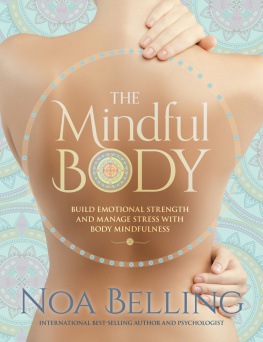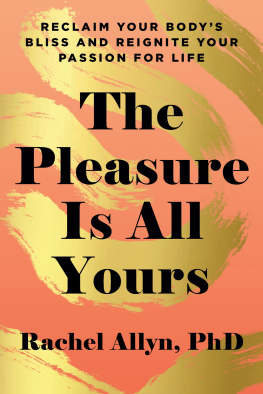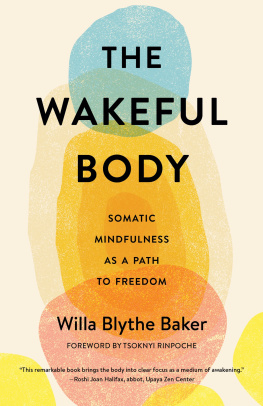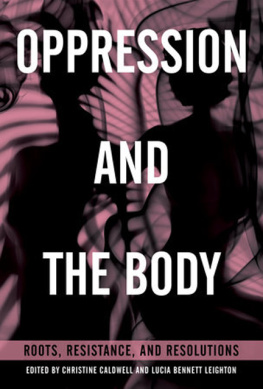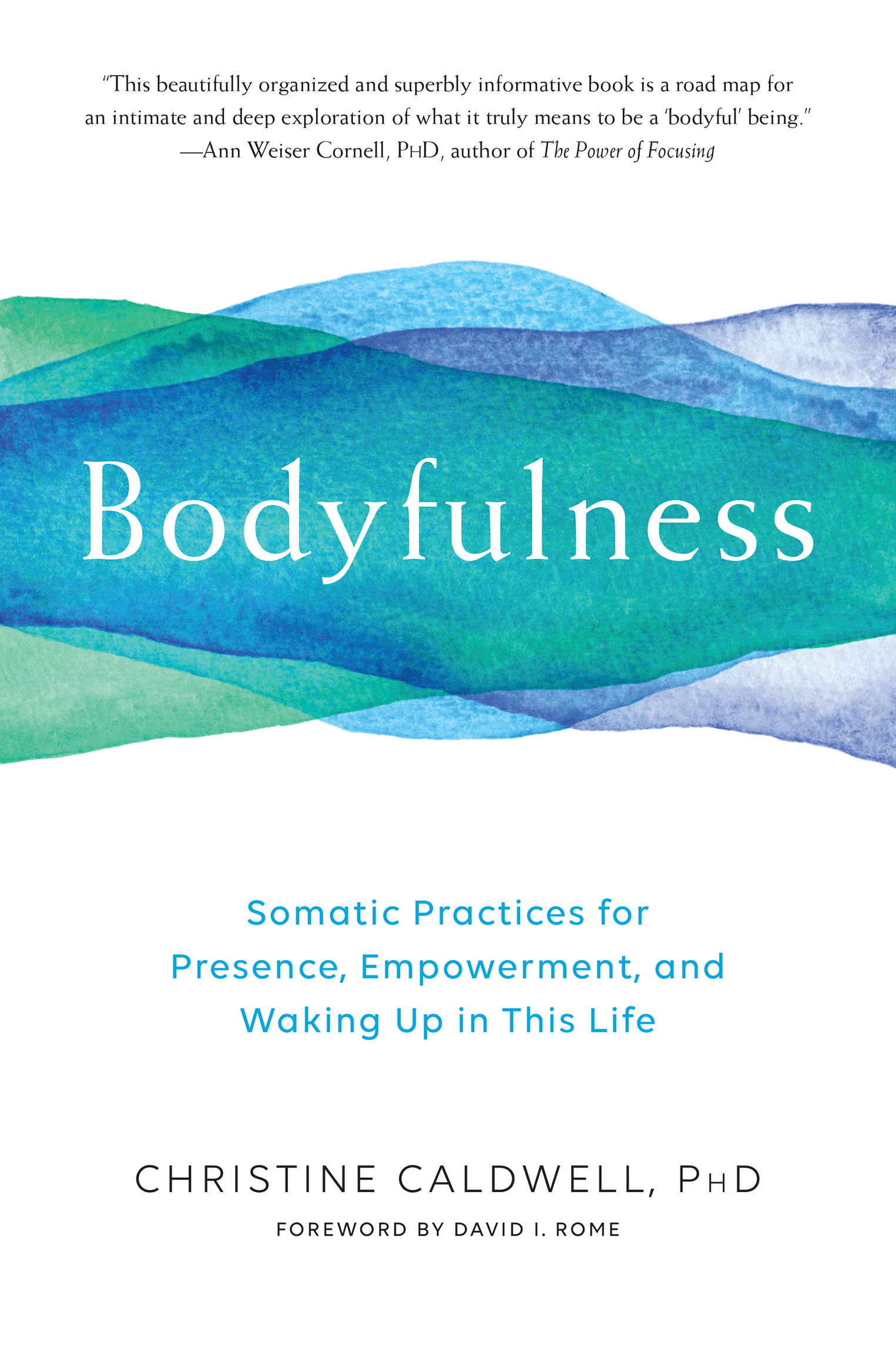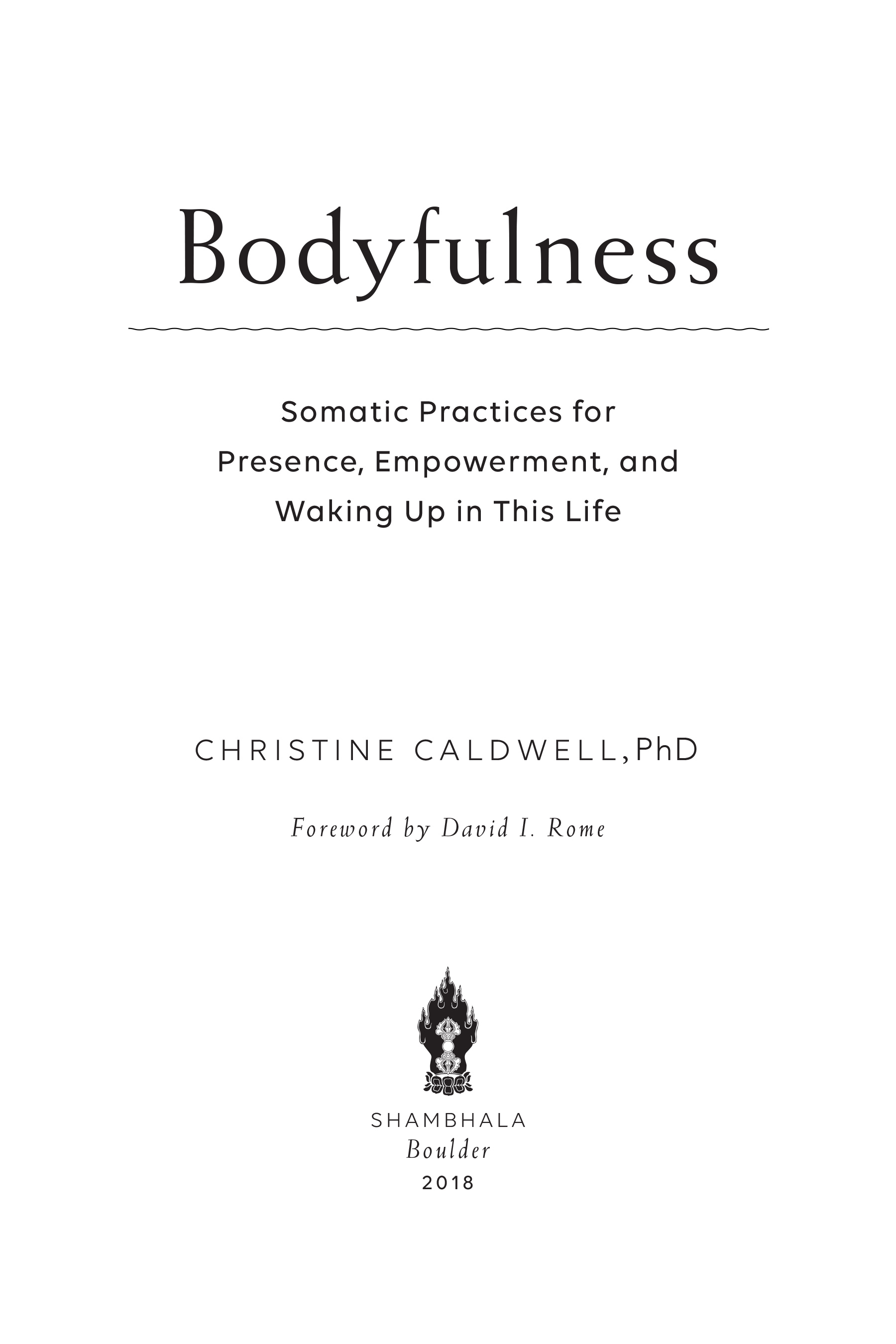Contents
Shambhala Publications, Inc.
4720 Walnut Street
Boulder, Colorado 80301
www.shambhala.com
2018 by Christine Caldwell
Small portions of the introduction, chapter 1, and chapter 7 were adapted from Christine Caldwell, Mindfulness and Bodyfulness: A New Paradigm, Journal of Contemplative Inquiry 1, no. 1 (2014): 7796. Small portions of chapter 5 were adapted from Himmat Kaur Victoria and Christine Caldwell, Breathwork in Body Psychotherapy: Towards a More Unified Theory and Practice, Body, Movement and Dance in Psychotherapy 6, no. 2 (2011): 89101. Small portions of chapter 8 were adapted from chapter 2 of Oppression and the Body: Roots, Resistances, and Reclamations, ed. Christine Caldwell and Lucia Bennett Leighton (Berkeley: North Atlantic Books, 2018): 3150.
All rights reserved. No part of this book may be reproduced in any form or by any means, electronic or mechanical, including photocopying, recording, or by any information storage and retrieval system, without permission in writing from the publisher.
Ebook design adapted from printed book design by Claudine Mansour Design
Cover design and illustration by Kathleen Lynch/Black Kat Design
L IBRARY OF C ONGRESS C ATALOGING - IN -P UBLICATION D ATA
Names: Caldwell, Christine, 1952 author.
Title: Bodyfulness: somatic practices for presence, empowerment, and waking up in this life / Christine Caldwell.
Description: Boulder: Shambhala, 2018. | Includes bibliographical references and index.
Identifiers: LCCN 2018006101 | ISBN 9781611805109 (pbk.: alk. paper)
eISBN9780834841697
Subjects: LCSH : Mind and body therapies.
Classification: LCC RC 489.M53 C 34 2018 | DDC 616.89/1dc23
LC record available at https://lccn.loc.gov/2018006101
v5.3.2
a
For my grandson,
Cooper
And my daughter-in-law,
Brianna
Contents
Foreword
I T TAKES AUDACITY to coin a new word in the English language. Wouldnt somatic awareness or embodied mindfulness have sufficed to describe the territory Christine Caldwell illuminates in this book? Do we really need the neologism bodyfulness? At face value, bodyfulness presents itself as the opposite of mindfulness. However, Caldwells intention here is subtler and more subversive. Because mind/body dualism has become so entrenched in our conceptual library, mindfulness as a term cannot avoid reaffirming the cultural bias that mind is superior to body. This is why we need a completely new term. Bodyfulness overcomes the bias toward the mental, while at the same time extending and greatly enriching the signification of mindfulness itself.
In fact, Christine Caldwells approach is extraordinary in the breadth of its concerns. Her knowledge of the field itself is comprehensivethe Additional Notes and References section alone is a tour de forceand she enlarges its relevance to todays society through her passionate embrace of the themes of contemplative awareness, ethical action, and social equity.
Bodyfulness begins when the embodied self is held in a conscious, contemplative environment. Its then coupled with nonjudgmental engagement with bodily processes, an acceptance and appreciation of ones bodily nature, and an ethical and aesthetic orientation toward taking right actions physically so that a lessening of suffering and an increase in human and nonhuman potential may emerge.
That is probably the most nuanced of several definitions of bodyfulness Caldwell offers. At another point she describes it more experientially:
The body isnt a thing we have but an experience we are. Bodyfulness is about working toward our potential as a whole human animal that breathes as well as thinks, moves as well as sits still, takes action as well as considers, and exists not just because it thinks but because it dances, stretches, bounces, gazes, focuses, and attunes to others.
Elsewhere she captures the essence of bodyfulness, memorably, in three words: attention during action.
The book begins by articulating eight core principles of body processes. The first, oscillation, provides a key to the other sevenand indeed to the whole book. The living body and its interdependent systems like respiration, digestion, circulation, and the nervous system are in a continual movement, without which the body cannot maintain its equilibrium. The heart contracts and releases, contracts and releases; the rate at which it does so speeds up and slows down in response to how much work the body has to do. Each physiological system oscillates along its own continuum of activity, and all of them oscillate interdependently, like the different instruments in an orchestra modulating between loud and soft, fast and slow, high and low notes, each following its own part in the score yet all together making an intricate, coherent, harmonious whole.
The body as a whole is a continuum of processes that range from those that are completely unconscious to those that we are fully conscious and in control of. As Caldwell demonstrates both in her topic-by-topic presentations and in their accompanying exercises, it is in the middle of this range, where previously unconscious functions and longstanding habitual patterns can be brought into the light of awareness, that somatic practices are particularly powerful. It is here too that Caldwell articulates what is probably her most original and important contribution to the field of somatic psychology: the vital role of embodied contemplative awareness.
Bodyfulness involves a purposeful and athletic ability to alter our attentional focus so that the amount and type of sensations we work with can be nourishing and deeply informativeWhile thinking evokes the mind, moving evokes the body. Movement and action form the system through which the body knows, identifies, remembers, and contemplates itself.
The second part of the book lays out four essential body functionssensing, breathing, moving, and relatingtogether with a menu of exercises for each. The instructions for these exercises are easy to follow, thorough, and precise, and at the same time suffused with contemplative and experiential wisdom. Here is how Caldwell concludes her description of the Balanced Breath practice:
Its important not to force [the pause at the end of the out-breath] to happen, as this defeats the physiological pause and disrupts the relaxation of the cycle. Simply watch for and greet the pause if it shows up, and bear witness as your body organizes itself to inhale again on its own physiological authority[N]otice what associations emergeas any conscious breathing will bring up potentially powerful and useful contemplations.
Caldwell differentiates bodyfulness from embodiment, an important word that, like mindfulness, has become rusty through overuse:
In embodiment we know what we feel and sense, but in bodyfulness we somatically reflect upon and even challenge our embodied experience in a way that tempers our compelling and habituated action patterns as well as our experiments with abusing power.
It is here Caldwell challenges the minds superiority over the body as an article of faith common to civilized societies. It is part and parcel of the self-serving and toxic belief that man holds heavenly sanctioned dominion over the animals (let alone plants and fungi). While the human capacity for cognition and metacognition is undoubtedly a supreme evolutionary achievement (for better and for worse, it becomes increasingly evident), the roots and purposes of human cognition lie entirely with the physical body. Mind is an outgrowth of and in service to the same life process that we share with all living organisms.



